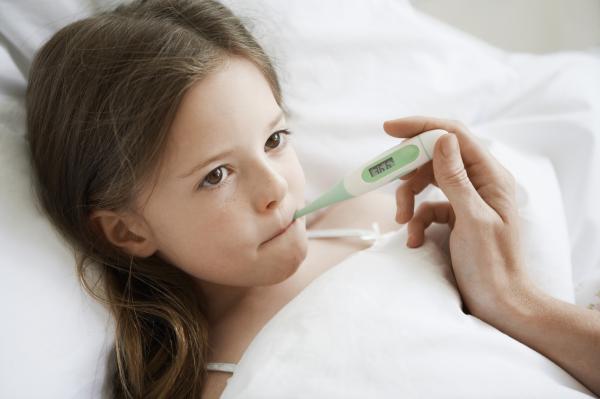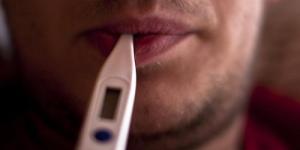Is a Body Temperature of 35.4°C, 35.5°C or 35.6°C Normal


Body temperature is very tightly regulated in humans, as various physiological activities require a specific temperature in order to function properly. The temperature of peripheral tissues, such as skin, mucous membranes, muscles or limbs, is variable depending on different factors. These different factors which influence body temperature regulation include; age, recent physical activity, menstrual cycle, consumption of food and fluids and even the time of the day.
An abnormal body temperature can be a sign that something is wrong in the body. However, what is considered a dangerous temperature for one person can be completely normal for another. Still, there are ways to find out whether your temperature is normal or not.
Is a body temperature of 35.4ºC, 35.5ºC or 35.6ºC normal? If your temperature ranges between 95.7 to 96ºF, is everything working as it should and are you healthy? Read this oneHOWTO article to find out more about your body temperature.
Body temperature below 35.6ºC in adults
A body temperature of 35.4°C, 35.5°C or 35.6°C (95.7°F, 95.9°F or 96°F) may seem close to the normal body temperature of 36.4ºC to 37.6ºC (97.5ºF to 99.6ºF). These are actually considered well below normal body temperature[1].
Here are some general body temperature categories:
- Hypothermia: Body temperature below 36°C (96.8°F). Since individual body temperatures vary, for some people hypothermia is lower than others. If you want to know more about hypothermia, we recommend taking a look at our article on: What is Hypothermia?
- Feverishness: Body temperature is between 37.1°C and 37.9°C (98.7 and 100.22°F).
- Hyperthermia or fever: Body temperature is at 38ºC (100.4ºF) or above.
Therefore, a body temperature below 35.6ºC (96ºF) in adults is not considered normal. Our body is able to thermoregulate - that is, to regulate its own temperature - to a tenth of a degree, but fluctuations of even one degree significantly affect bodily functions.
Depending on the circumstances of the adult below 35.6ºC, the low number could be a sign of hypothermia, and should be monitored closely.

Body temperature below 35.6ºC in children
A body temperature of 35.4°C, 35.5°C or 35.6°C (95.7°F, 95.9°F or 96°F) in children is generally not normal and requires immediate medical attention. Meanwhile, you can follow some necessary instructions on how to warm the body, such as; removing wet clothing, covering the person with warm, dry clothes and/or giving them warm liquids to drink.
The normal body temperature for children is of at least 36ºC (96.8ºF). If your child's temperature is lower than 36ºC , especially below a body temperature of 35.6ºC (96ºF), visit your pediatrician. A professional will know what should be the body temperature of your child according to their specific case, because as mentioned before, not everyone has the exact same characteristics and requirements when it comes to measuring body temperature.
Armpit temperature
There is more than one way to skin a cat and there is more than one way to take your temperature. We won't go into the different types of thermometers, but we will discuss the 3 main ways in which you can take body temperature.
Armpit temperature is naturally about half a degree lower than oral temperature. Armpit or axillary temperature of 35.4°C, 35.5°C or 35.6°C is a little low. In this case you should take measures to warm up the body, but it is not a very serious case. The reason why axillary or armpit temperature is generally lower is because of the type if skin on the armpit. Our skin has many purposes and one main function of skin is too work as a coolant. Skin is used to regulate our core temperature and, because it is on the outside of our bodies, it will cool down more quickly in cooler ambient temperatures. Clothing and physical activity prior to having axillary temperature taken can also have an affect on results.
Some children have a constant axillary temperature below 36°C (96.8°F), which is normal for them. This is known as physiological hypothermia. In this case, their body functions normally despite the lower than average body temperature. Consult your pediatrician for more if you think your child has physiological hypothermia.
Oral temperature
An oral temperature of 35.4°C, 35.5°C or 35.6°C (95.7°F, 95.9°F or 96°F) is generally too low and in this case the patients body should be warmed up immediately.
Measuring temperature orally is recommended for all patients except for those who are unconscious or suffering from; mental confusion, seizures or conditions affecting the nose, mouth or throat, as well as children under 6 years old.
Taking oral temperature is considered more accurate than taking skin or axillary temperature, but there are also mitigating factors. What you eat before your temperature has been taken can have an effect on your body temperature reading. Someone who has just eaten a bowl of ice cream, for example, will likely have a different temperature reading than some who has just eaten a hot bowl of chile[2]. Smoking and general chewing (chewing gum) can also raise and have an affect an oral temperature reading.
Tympanic temperature is a body temperature reading taken from the ear. This is generally higher than axillary temperatures.

Rectal temperature
The body's core temperature spot is inside body temperature as opposed to outside temperature which may be taken under the armpit. The ideal temperature is the temperature at which vital organs function at their best. This is why rectal (and also vaginal) temperature readings are the most reliable body temperature reading methods. This is also for the simple reason that they are in closer proximity to these such organs. Hypothermia and hyperthermia affect this core temperature of the body and can be very dangerous. This is why you should take rectal temperature if you are concerned the patient is suffering from over hypo or hyperthermia.
A rectal temperature of 35.4°C, 35.5°C or 35.6°C (95.7°F, 95.9°F or 96°F) is concerning and you should seek immediate medical assistance and raise the body’s temperature. The result of a rectal measurement tends to be 0.5°C - 0.7°C higher than that of oral temperatures, therefore, such a low result is definitely not normal.
Taking temperature rectally is recommended for babies and patients under 6 years of age. Any discomfort caused by rectal temperature readings should be taken into consideration when taking rectal temperature.
What factors affect body temperature?
There are various factors that can affect body temperature by a few tenths of a degree, but any body temperature below 35°C is very concerning.
The following are risk factors of hypothermia:
- Exposure to cold weather without proper clothing.
- Diabetes.
- Alcohol or drug intoxication and exposure to cold weather.
- Very young or very advanced age.
- Heat acclimatization. After long-term exercising in the heat, the body gets used to the temperature and develops a lower than average based body temperature.
- Diseases that impact the production of perspiration, such as heart, lung and kidney disorders.
- Diseases that cause an increase in heat production, such as infections, hyperthyroidism and any conditions that are accompanied by a fever.
- Use of certain drugs, such as sedatives, amphetamines and antidepressants.
- Mental disorders and states of acute or chronic alcohol consumption can decrease tolerance of excessive heat.

Body temperature and circadian rhythms
Just like the little dial in your hallway, your body has its own form of thermostat. There are different variables which affect your body temperature and they fluctuate during any given day. Body temperature control is also known commonly as thermoregulation. We require this body regulation because different activities and states of being result in different body temperatures which need to be controlled. Our circadian rhythm is the varying changes in processes which happen during any given 24 hour period.
The reason why we humans keep a 24 hour clock is not arbitrary. We sense light and time unconsciously and our body will change according to the time of day, for a variety of reasons. These changes in our body also affect our body temperatures. Some of the factors which can alter body temperature include:
Sleep
During sleep, our body is at rest and will not be carrying out the same activities as we might if we were active and awake. The lowest human body temperature during rest is known as the Basal body temperature (BBT) and this occurs most often during sleep. This is why this temperature is taken just before somebody wakes up. If a person sleeps at night and is awake during the day (something not common in everyone), then their body temperature is likely to be at its highest between 4 pm and 6 pm. This is often due to physical activity carried out during the day as well as eating and storage of energy. This means if you take a person's temperature at different times of the day, different variances should be taken into consideration.
Gender
Women are more likely to fluctuate naturally thanks to the rise and fall of particular hormones related to a woman’s menstrual cycle. After ovulation, a woman's Basal body temperature increases. This is why women practicing the rhythm method of contraception sometimes take their temperature to check their fertility levels. Similarly, women looking to conceive do the same thing. Hormonal contraceptives such as the pill work to repress fertility, but can also raise body temperature when doing so. If worried about a change in body temperature, this should be taken into consideration. Hormonal changes in general can affect body temperature for men or women, so those undergoing hormone replacement therapy or who are taking supplementary hormones should also be considerate of this.
Physical activity
Unsurprisingly, physical activity can also affect body temperature. If you are taking your temperature, but have just gone for a run, then physical exertion will lead to increased body temperature. Similarly, times of inaction or rest will have lowered body temperature. The clothing which one wears can also affect body temperature. Warmer clothing can, understandably, affect core and axillary body temperatures.
Overall health
Although worrisome health concerns can have an affect on body temperature and is a good indicator to tell if medical action is needed, overall health can be a also be a factor in measuring body temperature. If you are a healthy person, your body may use up more energy as it is more efficient. If you have a higher metabolism, then you will likely have a higher body temperature. This is why older people may have lower average body temperature than younger people. This is not because your metabolism slows down, but because your body's activity does. It is important for everyone to stay active, but particularly for older people as they need to keep their bodies regulated. According to The American Institute for Cancer Research, exercise and correct body regulation in older people can help decrease the risk of certain cancers.
Is a temperature below 35.6ºC dangerous?
Although a body temperature of 35.4°C, 35.5°C or 35.6°C (95.7°F, 95.9°F or 96°F) is not normal, it isn't necessarily dangerous if you are a healthy adult or child. Based on all of the above already mentioned factors, you will now whether or not that specific temperature is alright and healthy for your own body. If your temperature has dropped suddenly, you should call a doctor[3].
That being said, body temperatures below 35.4 (95.7ºF) is considered more alarming and definitely requires medical attention.
This article is merely informative, oneHOWTO does not have the authority to prescribe any medical treatments or create a diagnosis. We invite you to visit your doctor if you have any type of condition or pain.
If you want to read similar articles to Is a Body Temperature of 35.4°C, 35.5°C or 35.6°C Normal, we recommend you visit our Diseases & secondary effects category.
Tips
- Armpit temperature should be taken by placing a thermometer under the arm for a period of approximately 4 minutes.
- Visit your doctor and he/she will explain you which body temperature should be appropriate for your body.










